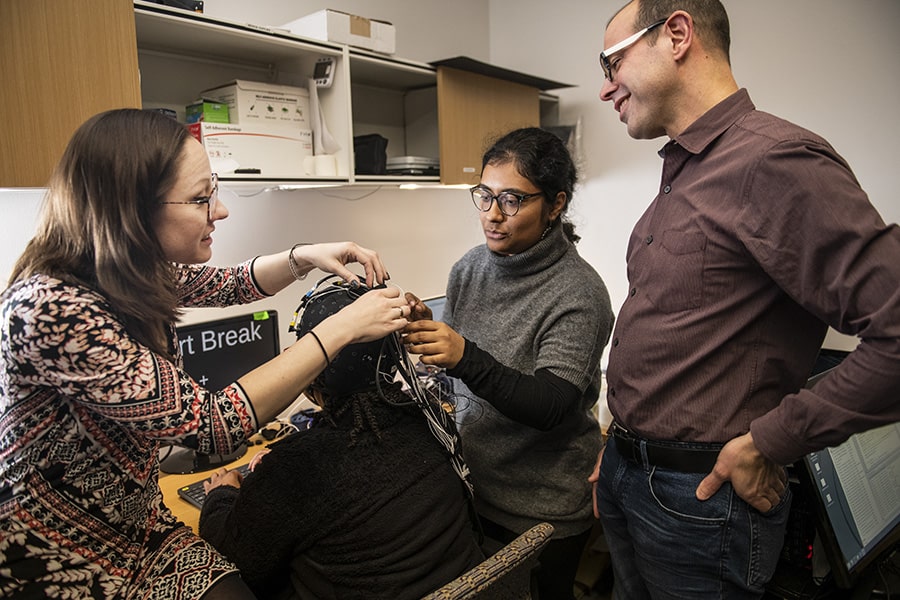
Collaboration Clusters Connect Pittsburgh Neuroscientists
Deepshikha Acharya adjusts the leads on a black EEG cap strapped to the head of a volunteer test subject in a research lab in Carnegie Mellon University's Scott Hall. Researchers from CMU and the University of Pittsburgh watch as the subject performs a series of tasks prompted by a computer screen and the special cap reads the neuronal activity in her brain.
Partnerships like this are making Pittsburgh a hotspot for neuroscience research.
Acharya is studying neurovascular coupling, or how neurons interact with blood vessels. A second year Ph.D. student co-advised by CMU's Jana Kainerstorfer and Matthew Smith, she is trying to understand how healthy and diseased brains react when the physical pressure in the head is altered, such as when someone has suffered a stroke or a head injury. But Acharya is not taking on this task alone.
The Neurovascular Coupling Interest Group — co-led by Kainerstorfer and Alberto Vasquez from Pitt — is one of the new Collaboration Clusters funded by the Center for the Neural Basis of Cognition (CNBC), CMU's joint training partnership with Pitt. What started as a journal club for researchers in Kainerstorfer's and Smiths' labs to review current literature is now a group that comprises more than 50 people, including psychologists, engineers, radiologists, clinicians and neuroscientists. Together, they're gaining a better understanding of the field from many different perspectives.
"All of the researchers in our group have similar interests but are used to looking at this field of neurovascular coupling with their own distinct methods," Kainerstorfer said. "The cluster gives us all the opportunity to expand the way we think by learning from each other."
The Collaboration Cluster program provides resources, up to $5,000 per year, for groups like Kainerstorfer's to explore focused topical areas in neuroscience with their colleagues. There are no strict rules on how they spend the money as long as the groups encourage Pitt and CMU faculty and trainees to exchange ideas, strengthen existing ties and build new collaborations. There are currently six funded Collaboration Clusters, with topics ranging from auditory neuroscience to perception and behavior. Self-organized groups can apply at any time as long as there is a strong representation from both CMU and Pitt.
The idea for the program started when Barbara Shinn-Cunningham, director of the Neuroscience Institute at CMU and Nathan Urban, professor and associate chair of the Department of Neurobiology at the University of Pittsburgh, were looking for a fresh way to create cross-disciplinary connections between the two universities. Shinn-Cunningham and Urban are co-directors of the CNBC.
"When the CNBC began there were about 40 people, everyone was on a first-name basis, and it was easy to keep track of each other's work," Shinn-Cunningham said. "Now, the neuroscience programs at both schools have expanded, and the intimacy of the early days is gone. We needed something new to connect people with shared interests."
Urban said that neuroscience research increasingly requires teams of scientists that cross disciplines.
"The scope and scale of neuroscience at Pitt and CMU provides a unique environment in which to address these problems," he said. "We want to provide a catalyst to get people talking, thinking and working together across the two campuses."
Steve Chase, associate professor of Biomedical Engineering and member of the Neuroscience Institute at CMU, is one of the leaders of the Neural Populations and Motor Control Collaboration Cluster. That group is interested in how the brain controls movement and had been working for a few years before formally organizing as a Collaboration Cluster. They devote the bulk of their time to reading papers, practicing talks and reviewing each other's abstracts ahead of big scientific meetings. Like all Collaboration Clusters, every meeting is open to anyone who would like to attend. Chase said he has been surprised by how many people attend the group regularly.
"One of the unexpected outcomes is that it's a great venue to help teach students communication skills," Chase said. "We're tough when we review papers and talks, but always leave the room feeling like we found a better way to tell the story about our work."
Shinn-Cunningham's ultimate hope is that the clusters will encourage joint publications and joint grant submissions. Some clusters, including Kainerstorfer's, are already seeing early progress toward these goals.
The Collaboration Clusters are just one example of joint CMU/Pitt neuroscience projects. The CNBC started in 1992, with funding from the R.K. Mellon Foundation for investigation of the cognitive and neural mechanisms that give rise to biological intelligence and behavior. Shinn-Cunningham joined in 2018 and has been impressed with how easy it is to work across universities.
"The Neuroscience Institute could not exist and be as strong without the close collaboration with Pitt. We don't have a medical school associated with us, but we can benefit from our wonderful neighbor, Pitt, who does. Meanwhile, within CMU, we have all the benefits of being small and intimate, which promotes interdisciplinary thinking," she said.
Acharya is seeing those benefits to her research already. She believes that by bringing together many researchers, the collaborative clusters will lead to big advances.
"Research cannot be done in isolation," Acharya said. "Collaborative clusters solve this problem. It's really nice to have help from different people, with different perspectives. More eyes on the problem makes for better science and faster discovery."